局部非均质性向扁平自由能景观的演化:PNN-PZ-PT在致形相边界上的压电响应优化
IF 3.8
Q2 CHEMISTRY, PHYSICAL
引用次数: 0
摘要
两种不同铁电系统的精确指定的组成景观-形态取向相边界(MPB) -具有超高的压电性,在热力学考虑下,通常有利于平坦的能量分布。当通过重新考察热稳定性和成分稳定性来制定基于三元的亲晶相边界成分时,一个更加奇特和技术上吸引人的相被解锁。局部结构非均质性是通过稀土掺杂优化压电性能的另一种通用途径,因为稀土掺杂引入了局部结构畸变。为了提高压电响应,我们将稀土Sm3+掺杂到0.55Pb(Ni1/3Nb2/3) O3-0.135PbZrO3-0.315PbTiO3三元相界面样品中。研究了Sm3+掺杂对0.55Pb(Ni1/3Nb2/3) O3-0.135PbZrO3-0.315PbTiO3的结构、微观结构、介电性能、铁电性能和压电性能的影响。介电光谱和序参量分析共同揭示了稀土掺杂导致的局部结构非均质性进一步软化了取向相边界的自由能格局。由于自由能平坦化,Sm3+掺杂体系的介电和压电响应显著增强。Sm3+掺杂后,压电系数从545pC/N (x = 0%)提高到810pC/N (x = 1%)。结果表明,通过稀土掺杂的异质结构调谐,可以进一步提高0.55Pb(Ni1/3Nb2/3) O3-0.135PbZrO3-0.315PbTiO3相变相界面的压电性能和铁性能。本文章由计算机程序翻译,如有差异,请以英文原文为准。

Evolution of local heterogeneity towards flat free energy landscape: Optimization of piezoelectric response in PNN-PZ-PT at morphotropic phase boundary
A precisely specified compositional landscape of two distinct ferroelectric systems – morphotropic phase boundary (MPB) – possesses ultrahigh piezoelectricity, where generically a flat energy profile is favoured under thermodynamic consideration. A more exotic and technologically appealing phase is unlocked when ternary-based morphotropic phase boundary compositions are formulated via revisiting the thermal and compositional stability. Local structure heterogeneity is another generic route towards optimization of the piezoelectric performance via rare earth doping, as rare-earth doping introduces the local structural distortions. To enhance piezoelectric response, we adopt rare earth Sm3+ doping into ternary based morphotropic phase boundary 0.55Pb(Ni1/3Nb2/3)O3–0.135PbZrO3–0.315PbTiO3 samples. The effect of Sm3+doping on the structure, microstructure, dielectric, ferroelectric and piezoelectric properties of 0.55Pb(Ni1/3Nb2/3)O3–0.135PbZrO3–0.315PbTiO3 were investigated. Dielectric spectroscopy and order parameter analysis collectively reveal that the free energy landscape of morphotropic phase boundary is further softened via local structural heterogeneity, enabled via rare earth doping. As a result of free energy flattening, dielectric and piezoelectric responses of Sm3+ doped system are significantly enhanced. Piezoelectric coefficient increases from 545pC/N (x = 0%) to 810pC/N (x = 1%) with Sm3+ doping. Observed results suggest that the piezoelectric and ferroic performances of morphotropic phase boundary based 0.55Pb(Ni1/3Nb2/3)O3–0.135PbZrO3–0.315PbTiO3 can further be improved by hetero-structural tuning via optimized rare earth doping.
求助全文
通过发布文献求助,成功后即可免费获取论文全文。
去求助
来源期刊

Chemical Physics Impact
Materials Science-Materials Science (miscellaneous)
CiteScore
2.60
自引率
0.00%
发文量
65
审稿时长
46 days
 求助内容:
求助内容: 应助结果提醒方式:
应助结果提醒方式:


